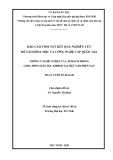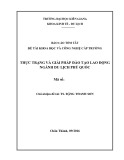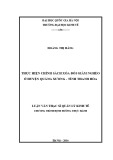
Hindawi Publishing Corporation
EURASIP Journal on Advances in Signal Processing
Volume 2011, Article ID 485738, 11 pages
doi:10.1155/2011/485738
Research Article
Acoustic Event Detection Based on Feature-Level Fusion of
Audio and Video Modalities
Taras Butko, Cristian Canton-Ferrer, Carlos Segura, Xavier Gir ´
o, Climent Nadeu,
Javier Hernando, and Josep R. Casas
Department of Signal Theory and Communications, TALP Research Center, Technical University of Catalonia, Campus Nord, Ed. D5,
Jordi Girona 1-3, 08034 Barcelona, Spain
Correspondence should be addressed to Taras Butko, taras.butko@upc.edu
Received 20 May 2010; Revised 30 November 2010; Accepted 14 January 2011
Academic Editor: Sangjin Hong
Copyright © 2011 Taras Butko et al. This is an open access article distributed under the Creative Commons Attribution License,
which permits unrestricted use, distribution, and reproduction in any medium, provided the original work is properly cited.
Acoustic event detection (AED) aims at determining the identity of sounds and their temporal position in audio signals. When
applied to spontaneously generated acoustic events, AED based only on audio information shows a large amount of errors,
which are mostly due to temporal overlaps. Actually, temporal overlaps accounted for more than 70% of errors in the real-
world interactive seminar recordings used in CLEAR 2007 evaluations. In this paper, we improve the recognition rate of acoustic
events using information from both audio and video modalities. First, the acoustic data are processed to obtain both a set of
spectrotemporal features and the 3D localization coordinates of the sound source. Second, a number of features are extracted
from video recordings by means of object detection, motion analysis, and multicamera person tracking to represent the visual
counterpart of several acoustic events. A feature-level fusion strategy is used, and a parallel structure of binary HMM-based
detectors is employed in our work. The experimental results show that information from both the microphone array and video
cameras is useful to improve the detection rate of isolated as well as spontaneously generated acoustic events.
1. Introduction
The detection of the acoustic events (AEs) naturally pro-
duced in a meeting room may help to describe the human
and social activity. The automatic description of interac-
tions between humans and environment can be useful for
providing implicit assistance to the people inside the room,
providing context-aware and content-aware information
requiring a minimum of human attention or interruptions
[1], providing support for high-level analysis of the under-
lying acoustic scene, and so forth. In fact, human activity
is reflected in a rich variety of AEs, either produced by the
human body or by objects handled by humans. Although
speech is usually the most informative AE, other kind of
sounds may carry useful cues for scene understanding. For
instance,inameeting/lecturecontext,wemayassociatea
chair moving or door noise to its start or end, cup clinking to
acoffee break, or footsteps to somebody entering or leaving.
Furthermore, some of these AEs are tightly coupled with
human behaviors or psychological states: paper wrapping
may denote tension; laughing, cheerfulness; yawning in the
middle of a lecture, boredom; keyboard typing, distraction
from the main activity in a meeting; clapping during a
speech, approval. Acoustic event detection (AED) is also
useful in applications as multimedia information retrieval,
automatic tagging in audio indexing, and audio context
classification. Moreover, it can contribute to improve the
performance and robustness of speech technologies such as
speech and speaker recognition and speech enhancement.
Detection of acoustic events has been recently performed
in several environments like hospitals [2], kitchen rooms
[3], or bathrooms [4]. For meeting-room environments, the
task of AED is relatively new; however, it has already been
evaluated in the framework of two international evaluation
campaigns: in CLEAR (Classification of Events, Activities,
and Relationships evaluation campaigns) 2006 [5], by three
participants, and in CLEAR 2007 [6], by six participants.
In the last evaluations, 5 out of 6 submitted systems
showed accuracies below 25%, and the best system got
33.6% accuracy [7]. In most submitted systems, the standard

2 EURASIP Journal on Advances in Signal Processing
combination of cepstral coefficients and hidden Markov
model (HMM) classifiers widely used in speech recognition
is exploited. It has been found that the overlapping segments
account for more than 70% of errors produced by every
submitted system.
The overlap problem may be tackled by developing more
efficient algorithms either at the signal level using source
separation techniques like independent component analysis
[8]; at feature level, by means of using specific features [9]
or at the model level [10]. Another approach is to use an
additional modality that is less sensitive to the overlap phe-
nomena present in the audio signal. In fact, most of human-
produced AEs have a visual correlate that can be exploited
to enhance the detection rate. This idea was first presented
in [11], where the detection of footsteps was improved by
exploiting the velocity information obtained from a video-
based person-tracking system. Further improvement was
shown in our previous papers [12,13], where the concept
of multimodal AED is extended to detect and recognize the
set of 11 AEs. In that work, not only video information but
also acoustic source localization information was considered.
In the work reported here, we use a feature-level
fusion strategy and a structure of the HMM-based system
which considers each class separately, using a one-against-all
strategy for training. To deal with the problem of insufficient
number of AE occurrences in the database we used so far,
1 additional hour of training material has been recorded
for the presented experiments. Moreover, video feature
extraction is extended to 5 AE classes, and the additional
“Speech” class is also evaluated in the final results. A
statistical significance test is performed individually for each
acoustic event. The main contribution of the presented work
is twofold. First, the use of video features, which are new
for the meeting-room AED task. Since the video modality
is not affected by acoustic noise, the proposed features may
improve AED in spontaneous scenario recordings. Second,
the inclusion of acoustic localization features, which, in
combination with usual spectrotemporal audio features,
yield further improvements in recognition rate.
The rest of this paper is organized as follows. Section 2
describes the database and metrics used to evaluate the
performance. The feature extraction process from audio and
video signals is described in Sections 3and 4, respectively.
In Section 5, both the detection system and the fusion
of different modalities are described. Section 6 presents
the obtained experimental results, and, finally, Section 7
provides some conclusions.
2. Database and Metrics
There are several publicly available multimodal databases
designed to recognize events, activities, and their relation-
ships in interaction scenarios [1]. However, these data are
not well suited to audiovisual AED since the employed
cameras do not provide a close view of the subjects under
study. A new database has been recorded with 5 calibrated
cameras at a resolution of 768 ×576 at 25 fps, and 6 T-
shaped 4-microphone clusters are also employed, sampling
the acoustic signal at 44.1 kHz. Synchronization among
all sensors is fulfilled. This database includes two kinds
of datasets: 8 recorded sessions of isolated AEs, where 6
different participants performed 10 times each AE, and a
spontaneously generated dataset which consists of 9 scenes
about 5 minutes long with 2 participants that interact
with each other in a natural way, discuss certain subject,
drink coffee, speak on the mobile phone, and so forth.
Although the interactive scenes were recorded according to a
previously elaborated scenario, we call this type of recordings
“spontaneous” since the AEs were produced in a realistic
seminar style with possible overlap with speech. Besides, all
AEs appear with a natural frequency; for instance, applause
appears much less frequently (1 instance per scene) than
chair moving (around 8–20 instances per scene). Manual
annotation of the data has been done to get an objective
performance evaluation. This database is publicly available
from the authors.
The considered AEs are presented in Ta ble 1, along with
theirnumberofoccurrences.
The metric referred to AED-ACC (1)isemployedto
assess the final accuracy of the presented algorithms. This
metric is defined as the F-score (the harmonic mean between
precision and recall)
AED-ACC =2∗Precision ∗Recall
Precision + Recall ,(1)
where
Precision =number of correct system output AEs
number of all system output AEs ,
Recall =number of correctly detected reference AEs
number of all reference AEs .
(2)
A system output AE is considered correct if at least
one of two conditions is met. (1) There exists at least one
reference AE whose temporal centre is situated between the
timestamps of the system output AE, and the labels of the
system output AE and the reference AE are the same. (2) Its
temporal centre lies between the timestamps of at least one
reference AE, and the labels of both the system output AE
and the reference AE are the same. Similarly, a reference AE is
considered correctly detected if at least one of two conditions
is met. (1) There exists at least one system output AE whose
temporal centre is situated between the timestamps of the
reference AE, and the labels of both the system output AE
and the reference AE are the same. (2) Its temporal centre
lies between the timestamps of at least one system output AE,
and the labels of the system output AE and the reference AE
are the same.
The AED-ACC metric was used in the last CLEAR 2007
[6] international evaluation, supported by the European
Integrated project CHIL [1] and the US National Institute
of Standards and Technology (NIST).
3. Audio Feature Extraction
The basic features for AED come from the audio signals. In
our work, a single audio channel is used to compute a set of

EURASIP Journal on Advances in Signal Processing 3
Table 1: Number of occurrences per acoustic event class for train
and test data.
Acoustic event Label Number of occurrences
Isolated Spontaneously generated
Door knock [kn] 79 27
Door open/slam [ds] 256 82
Steps [st] 206 153
Chair moving [cm] 245 183
Spoon/cup jingle [cl] 96 48
Paper work [pw] 91 146
Key jingle [kj] 82 41
Keyboard typing [kt] 89 81
Phone ring [pr] 101 29
Applause [ap] 83 9
Cough [co] 90 24
Speech [sp] 74 255
audio spectrotemporal (AST) features. That kind of features,
which are routinely used in audio and speech recognition
[2–4,7,10,14], describe the spectral envelope of the audio
signal within a frame and its temporal evolution along several
frames. However, this type of information is not sufficient
to deal with the problem of AED in presence of temporal
overlaps. In the work reported here, we firstly propose to
use the additional audio information from a microphone
array available in the room, by extracting features which
describe the spatial location of the produced AE in the 3D
space. Although both types of features (AST and localization
features) are originated from the same physical acoustic
source, they are regarded here as features belonging to two
different modalities.
3.1. Spectrotemporal Audio Features. A set of audio spec-
trotemporal features is extracted to describe every audio
signal frame. In our experiments, the frame length is 30 ms
with 20 ms shift, and a Hamming window is applied. There
exist several alternative ways of parametrically representing
the spectrum envelope of audio signals. The mel-cepstrum
representation is the most widely used in recognition tasks.
In our work, we employ a variant called frequency-filtered
(FF) log filter-bank energies (LFBEs) [14]. It consists of
applying, for every frame, a short-length FIR filter to the
vector of log filter-bank energies vector, along the frequency
variable. The transfer function of the filter is z-z−1,andthe
end points are taken into account. That type of features has
been successfully applied not only to speech recognition but
also to other speech technologies like speaker recognition
[15]. In the experiments, 16 FF-LFBEs are used, along
with their first temporal derivatives, the latter representing
the temporal evolution of the envelope. Therefore, a 32-
dimensional feature vector is used.
3.2. Localization Features. In order to enhance the recog-
nition results, acoustic localization features are used in
combination with the previously described AST features.
In our case, as the characteristics of the room are known
beforehand (Figure 1(a)), the position (x,y,z)oftheacoustic
source may carry useful information. Indeed, some acoustic
events can only occur at particular locations, like door slam
and door knock can only appear near the door, or footsteps
and chair moving events take place near the floor. Based
on this fact, we define a set of metaclasses that depend
on the position where the acoustic event is detected. The
proposed metaclasses and their associated spatial features are
“near door” and “far door,” related to the distance of the
acoustic source to the door, and “below table,” “on table,” and
“above table” metaclasses depending on the z-coordinate of
the detected AE. The height-related metaclasses are depicted
in Figure 1(b), and their likelihood function modelled via
Gaussian mixture models (GMMs) can be observed in
Figure 2(b). It is worth noting that the z-coordinate is not
a discriminative feature for those AEs that are produced at
the similar height.
The acoustic localization system used in this work is
based on the SRP-PHAT [16] localization method, which
is known to perform robustly in most scenarios. The
SRP-PHAT algorithm is briefly described in the following.
Consider a scenario provided with a set of NMmicrophones
from which we choose a set of microphone pairs, denoted as
Ψ.LetXiand Xjbe the 3D location of two microphones iand
j. The time delay of a hypothetical acoustic source placed at
x∈R3is expressed as
τx,i,j=
x−xi−
x−xj
s,(3)
where sis the speed of sound. The 3D space to be analyzed is
quantized into a set of positions with typical separations of 5
to 10 cm. The theoretical TDoA τx,i,jfrom each exploration
position to each microphone pair is precalculated and stored.
PHAT-weighted cross correlations of each microphone pair
are estimated for each analysis frame [17]. They can be
expressed in terms of the inverse Fourier transform of the
estimated cross-power spectral density Gi,j(f) as follows:
Ri,j(τ)=∞
−∞
Gi,jf
Gi,jf
ej2πfτdf. (4)
The contribution of the cross correlation of every
microphone pair is accumulated for each exploration region
using the delays precomputed in (4). In this way, we obtain
an acoustic map at every time instant, as depicted in
Figure 2(a). Finally, the estimated location of the acoustic
source is the position of the quantized space that maximizes
the contribution of the cross correlation of all microphone
pairs
x=argmax
x
i,j∈Ψ
Ri,jτx,i,j.(5)
The sum of the contributions of each microphone pair
crosscorrelation gives a value of confidence of the estimated
position, which is assumed to be well correlated with the
likelihood of the estimation.

4 EURASIP Journal on Advances in Signal Processing
x
y
5.245 m
3.966 m
16
13
14
15
12
09
10
11
19
20
18
17
05 08
06
07
22
23
24
21
02
03
04
01
Cam 5
Cam Cam 3
CamCam 1
Cam 2
P2
P1
Cam 4
zenithal
cam
(a)
Above
table
AEs
On
table
AEs
Below
table
AEs
(b)
Figure 1: (a) The top view of the room. (b) The three categories along the vertical axis.
AE applause AE chair moving
(a) Acoustic maps
0 0.25 0.5 0.75 1 1.25 1.5 1.75 2
Normalized PDF
Normalized PDF
AEs near door
AEs far door
0 400 800 1200 1600 2000
AEs below table
AEs on table
AEs above table
Height (z-coordinate) Log-distance from the door
(b) AE localization distributions
Figure 2: Acoustic localization. In (a), acoustic maps corresponding to two AEs overlaid to a zenithal camera view of the analyzed scenario.
In (b), the likelihood functions modelled by GMMs.

EURASIP Journal on Advances in Signal Processing 5
4. Video Feature Extraction
AED is usually addressed from an audio perspective only.
Typically, low acoustic energy AEs as paper wrapping,
keyboard typing, or footsteps are hard to be detected using
only the audio modality. The problem becomes even more
challenging in the case of signal overlaps. Since the human-
produced AEs have a visual correlate, it can be exploited
to enhance the detection rate of certain AEs. Therefore, a
number of features are extracted from video recordings by
means of object detection, motion analysis, and multicamera
person tracking to represent the visual counterpart of 5
classes of AEs. From the audio perspective, the video
modality has an attractive property; the disturbing acoustic
noiseusuallydoesnothaveacorrelateinthevideosignal.In
this section, several video technologies which provide useful
features for our AED task are presented.
4.1. Person Tracking Features. Tracking of multiple people
present in the analysis area basically produces two figures
associated with each target position and velocity. As it has
been commented previously, acoustic localization is directly
associated with some AEs but, for the target’s position
obtained from video, this assumption cannot be made.
Nonetheless, target’s velocity is straightforward associated
with footstep AE. Once the position of the target is known,
an additional feature associated with the person can be
extracted: height. When analyzing the temporal evolution
of this feature, sudden changes of it are usually correlated
with chair moving AE, that is, when the person sits down or
stands up. The derivative of height position along the time is
employed to address the “Chair moving” detection. Multiple
cameras are employed to perform tracking of multiple
interacting people in the scene, applying the real-time
performance algorithm presented in [18]. This technique
exploits spatial redundancy among camera views towards
avoiding occlusion and perspective issues by means of a
3D reconstruction of the scene. Afterwards, an efficient
Monte Carlo-based tracking strategy retrieves an accurate
estimation of both the location and velocity of each target
at every time instant. An example of the performance of this
algorithm is shown in Figure 3(a). The likelihood functions
of velocity feature for class “Steps” and metaclass “Nonsteps”
are shown in Figure 3(b).
4.2. Color-Specific MHE Features. Some AEs are associated
with motion of objects around the person. In particular,
we would like to detect a motion of a white object in
the scene that can be associated to paper wrapping (under
the assumption that a paper sheet is distinguishable from
the background color). In order to address the detection
of white paper motion, a close-up camera focused on
the front of the person under study is employed. Motion
descriptors introduced by [19], namely, the motion history
energy (MHE) and image (MHI), have been found useful
to describe and recognize actions. However, in our work,
only the MHE feature is exploited, since the MHI descriptor
encodes the structure of the motion, that is, how the action is
executed; this cue does not provide any useful information to
increase the classifier performance. Every pixel in the MHE
image contains a binary value denoting whether motion
has occurred in the last τframes at that location. In the
original technique, silhouettes were employed as the input
to generate these descriptors, but they are not appropriate
in our context since motion typically occurs within the
silhouette of the person. Instead, we propose to generate the
MHE from the output of a pixel-wise color detector, hence
performing a color/region-specific motion analysis that
allows distinguishing motion for objects of a specific color.
For paper motion, a statistic classifier based on a Gaussian
model in RGB is used to select the pixels with whitish color.
In our experiments, τ=12 frames produced satisfactory
results. Finally, a connected component analysis is applied to
the MHE images, and some features are computed over the
retrieved components (blobs). In particular, the area of each
blob allows discarding spurious motion. In the paper motion
case, the size of the biggest blob in the scene is employed
to address paper wrapping AE detection. An example of this
technique is depicted in Figure 4.
4.3. Object Detection. Detection of certain objects in the
scene can be beneficial to detect some AEs such as phone
ringing, cup clinking, or keyboard typing. Unfortunately,
phones and cups are too small to be efficiently detected
in our scenario, but the case of a laptop can be correctly
addressed. In our case, the detection of laptops is performed
from a zenithal camera located at the ceiling. The algorithm
initially detects the laptop’s screen and keyboard separately
and, in a second stage, assesses their relative position and size.
Captured images are segmented to create an initial partition
of 256 regions based on color similarity. These regions are
iteratively fused to generate a binary partition tree (BPT),
a region-based representation of the image that provides
segmentation at multiple scales [20]. Starting from the initial
partition, the BPT is built by iteratively merging the two most
similar and neighboring regions, defining a tree structure
whose leaves represent the regions at the initial partition and
the root corresponds to the whole image (see Figure 5(a)).
Thanks to this technique, the laptop parts may be detected
not only at the regions in the initial partition but also at some
combinations of them, represented by the BPT nodes. Once
the BPT is built, visual descriptors are computed for each
region represented at its nodes. These descriptors represent
color, area, and location features of each segment.
The detection problem is posed as a traditional pattern
recognition case, where a GMM-based classifier is trained
for the screen and keyboard parts. A subset of ten images
representing the laptop at different positions in the table
has been used to train a model based on the region-based
descriptors of each laptop part, as well as their relative
position and sizes. An example of the performance of this
algorithm is shown in Figure 5(b). For further details on the
algorithm, the reader is referred to [21].
4.4. Door Activity Features. In order to visually detect door
slam AE, we considered exploiting the a priori knowledge


![Liệu pháp nội tiết trong mãn kinh: Báo cáo [Mới nhất]](https://cdn.tailieu.vn/images/document/thumbnail/2024/20240705/sanhobien01/135x160/4731720150416.jpg)























